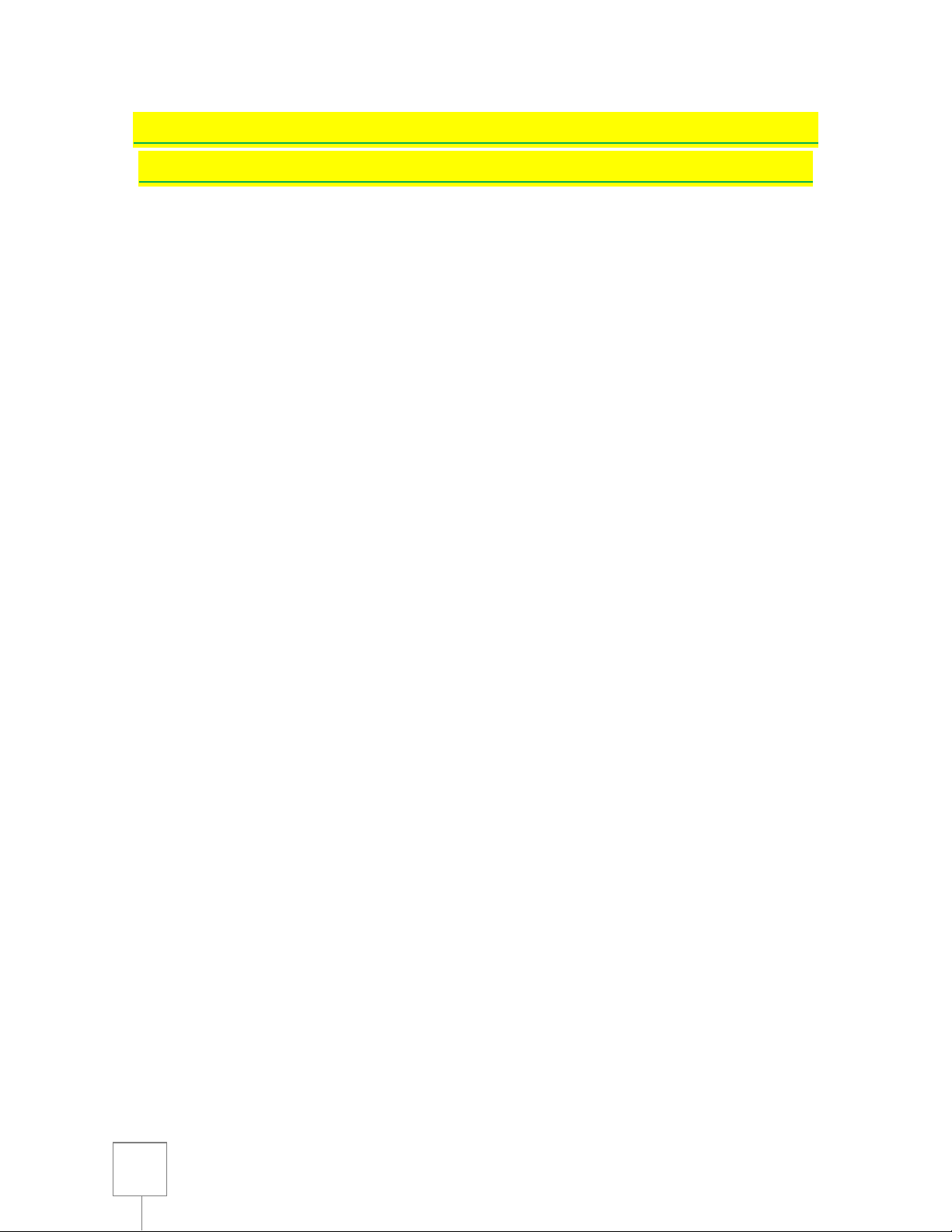
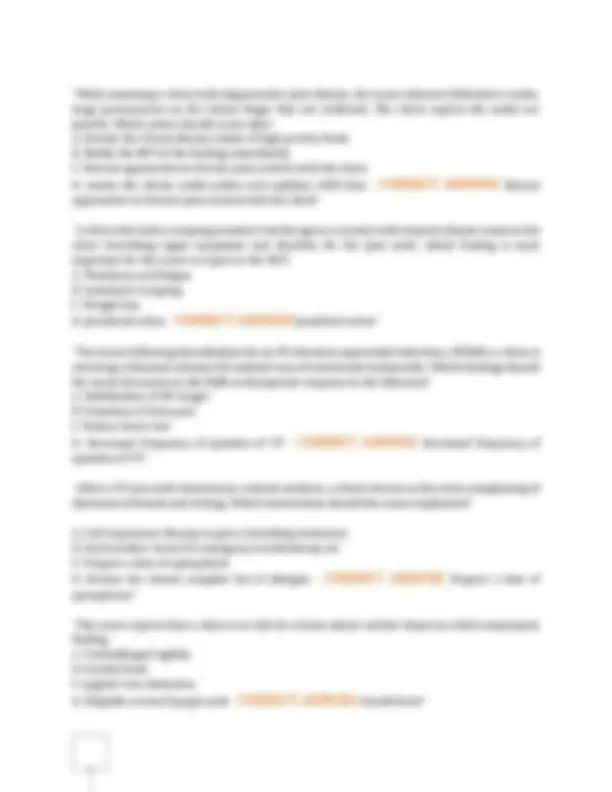
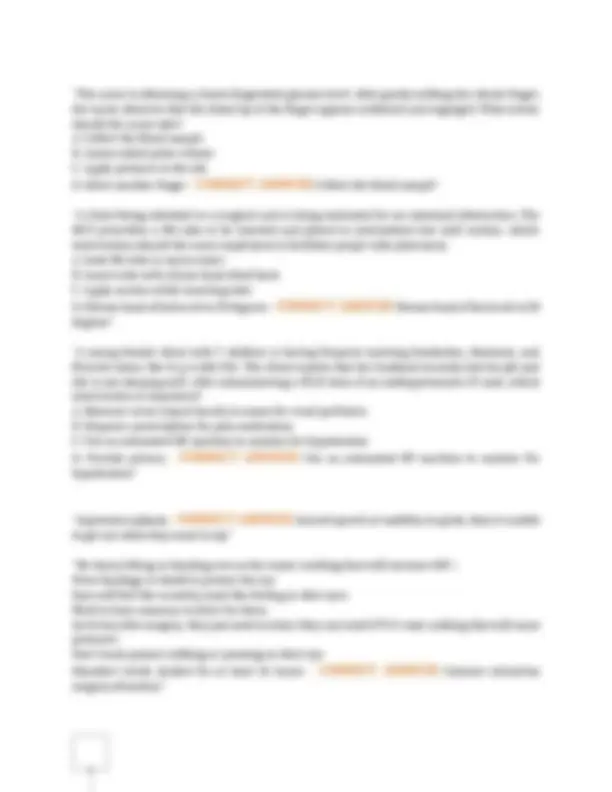
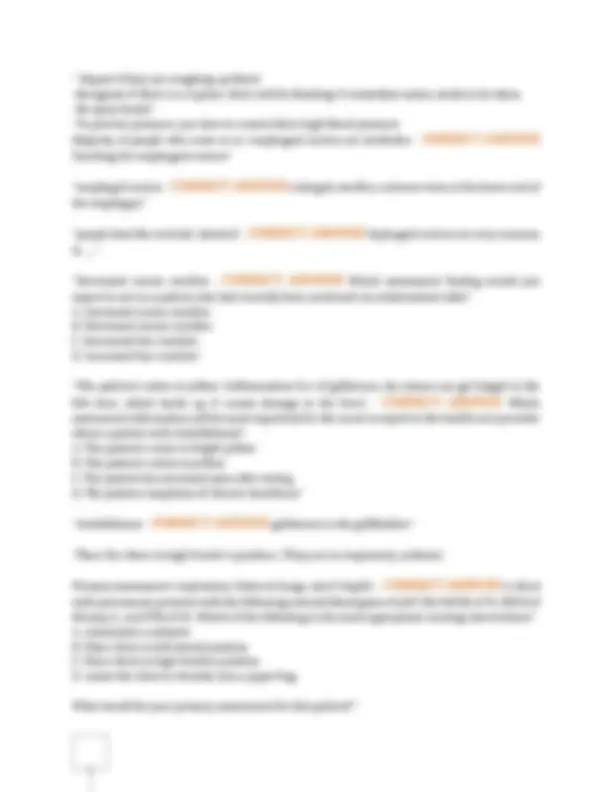
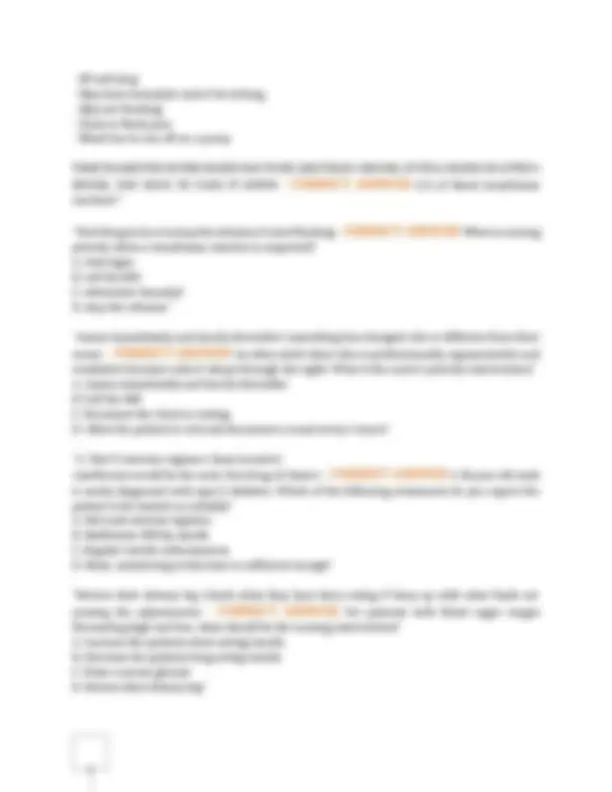
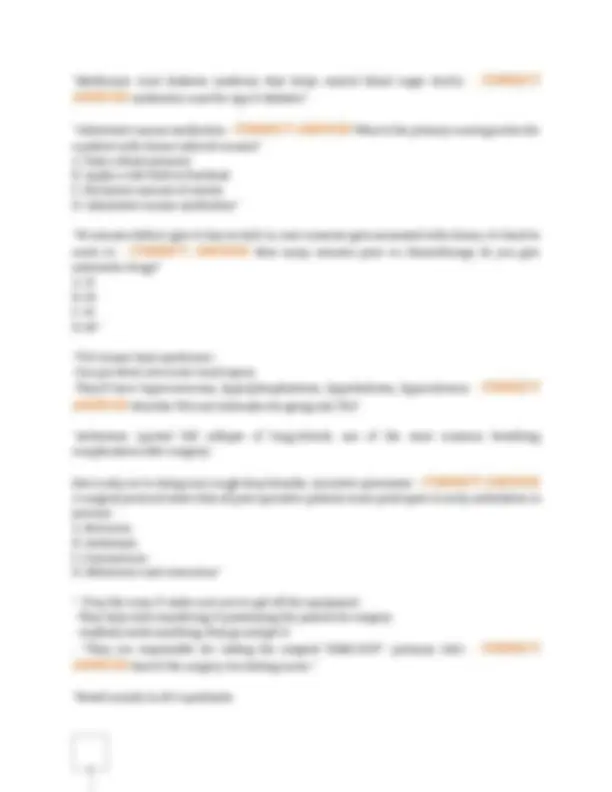
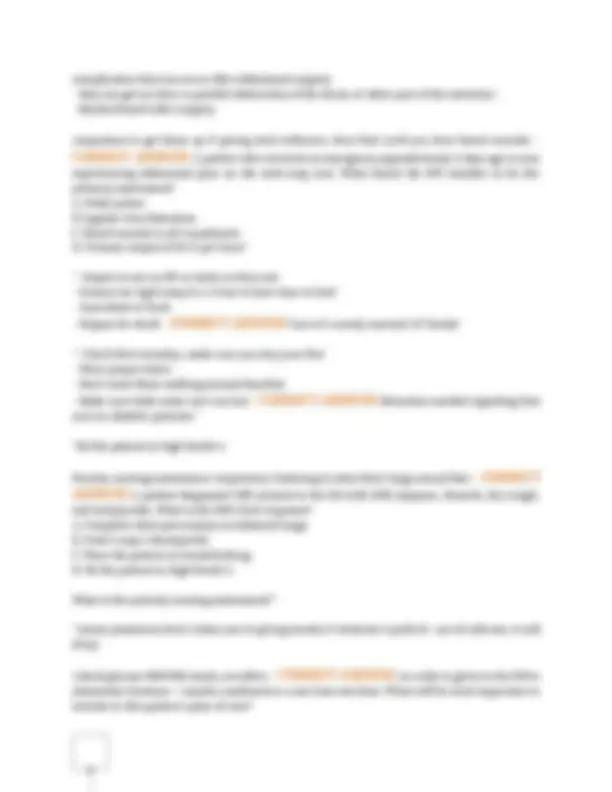
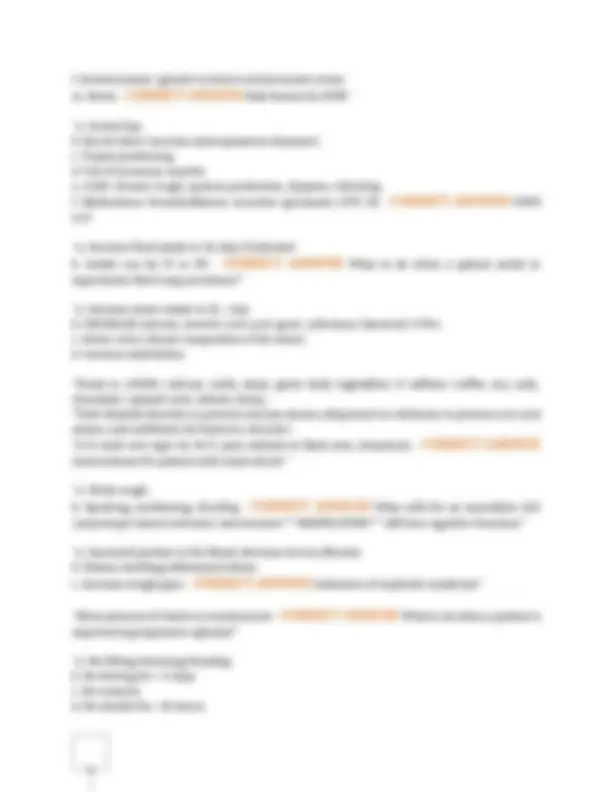
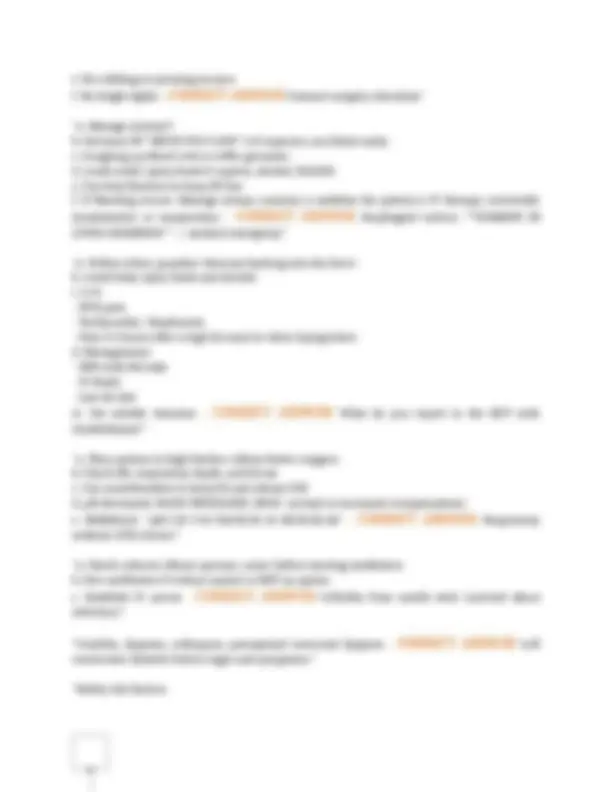
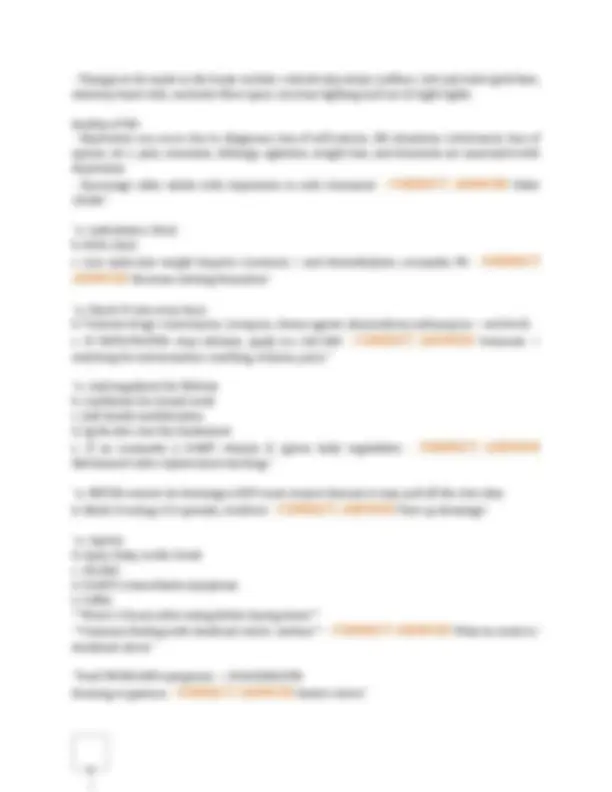
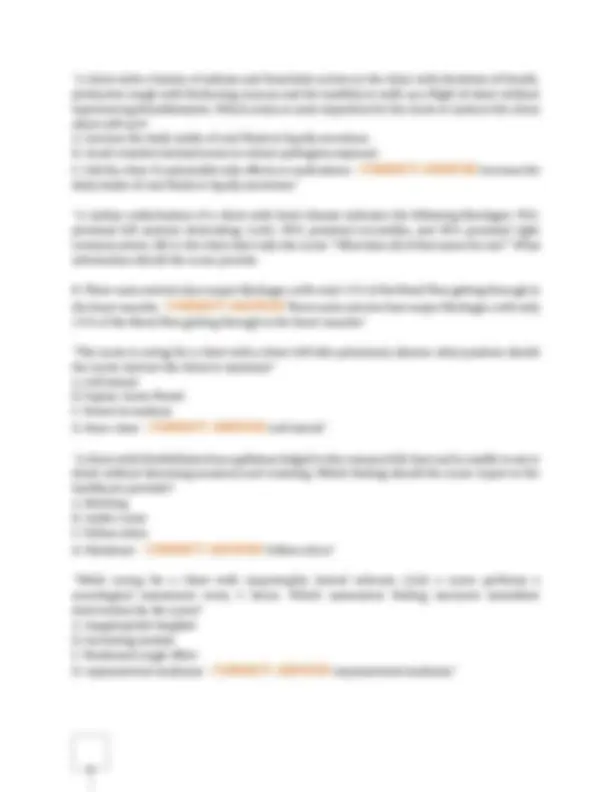
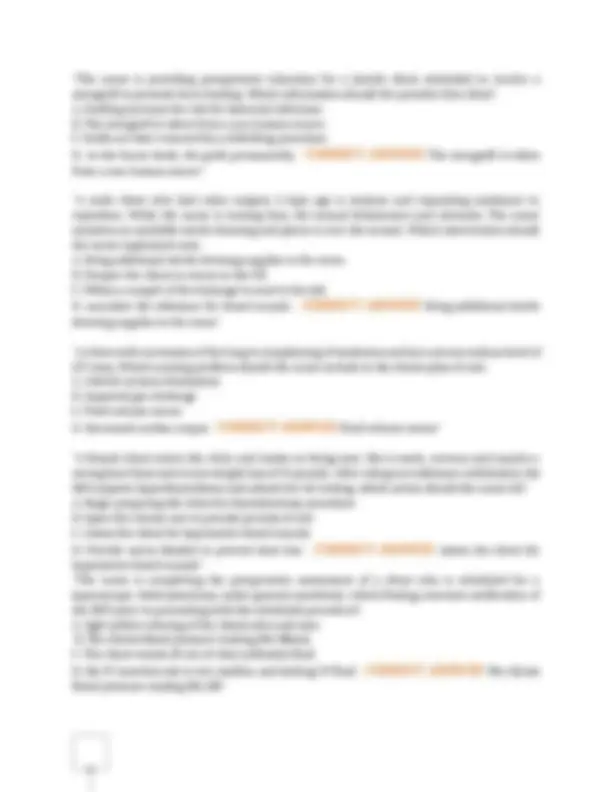
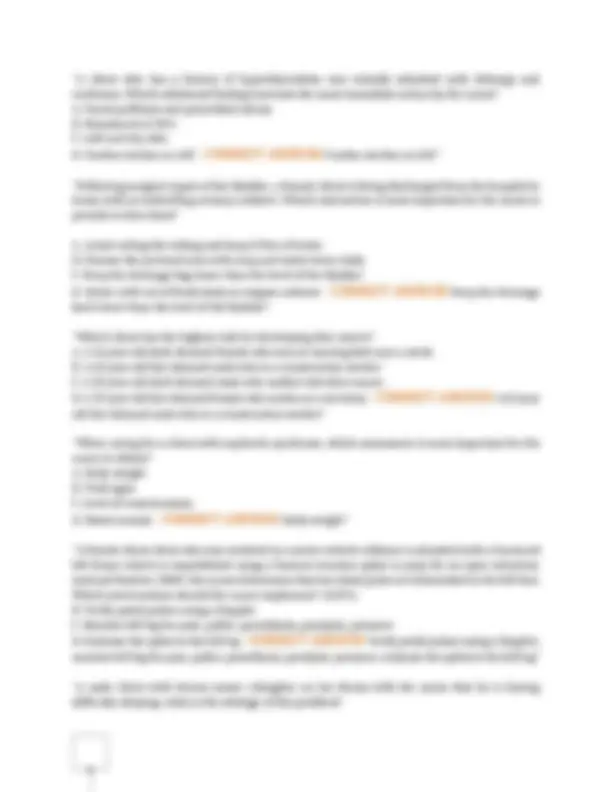
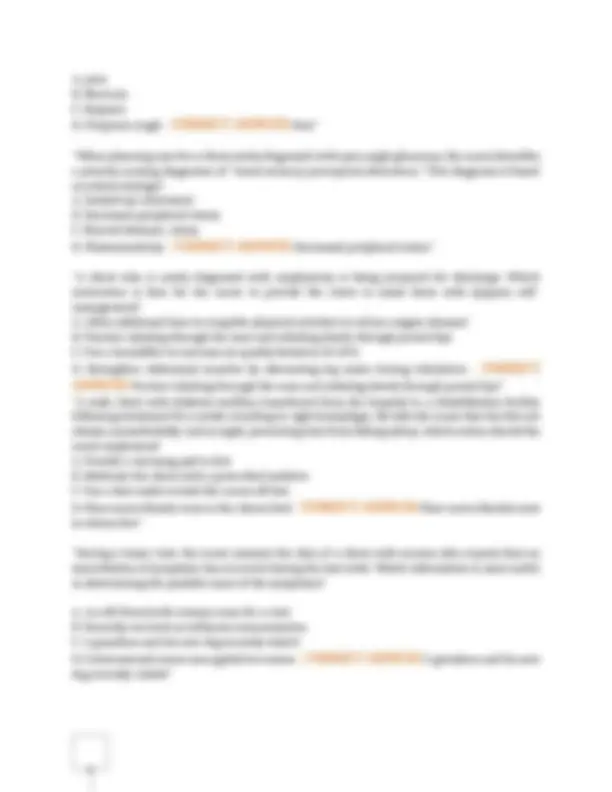
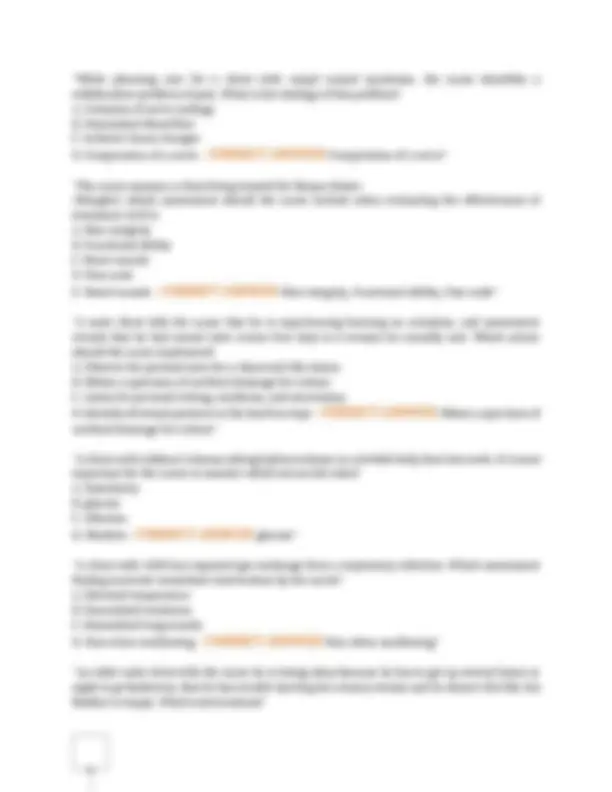
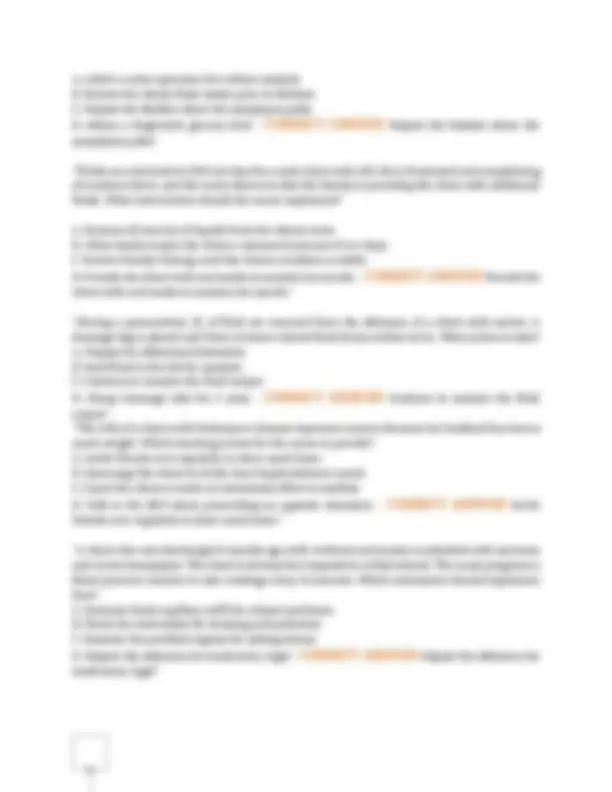
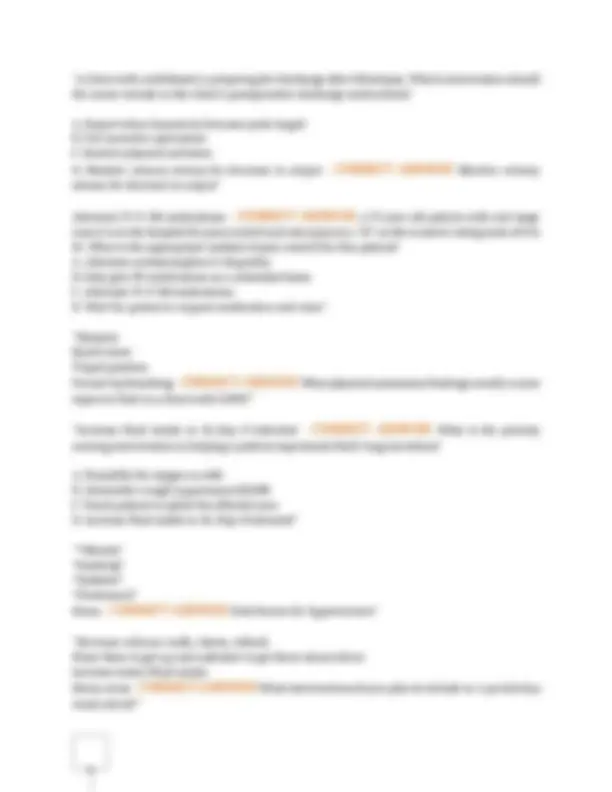
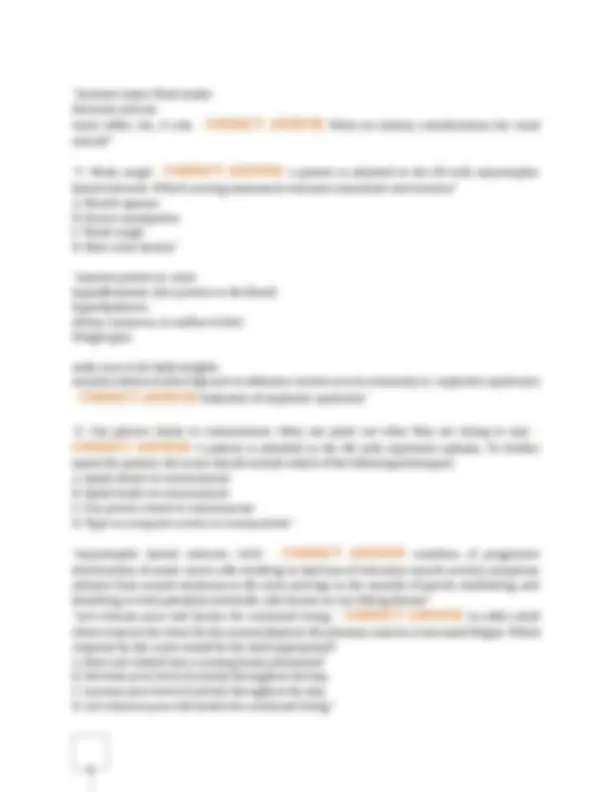
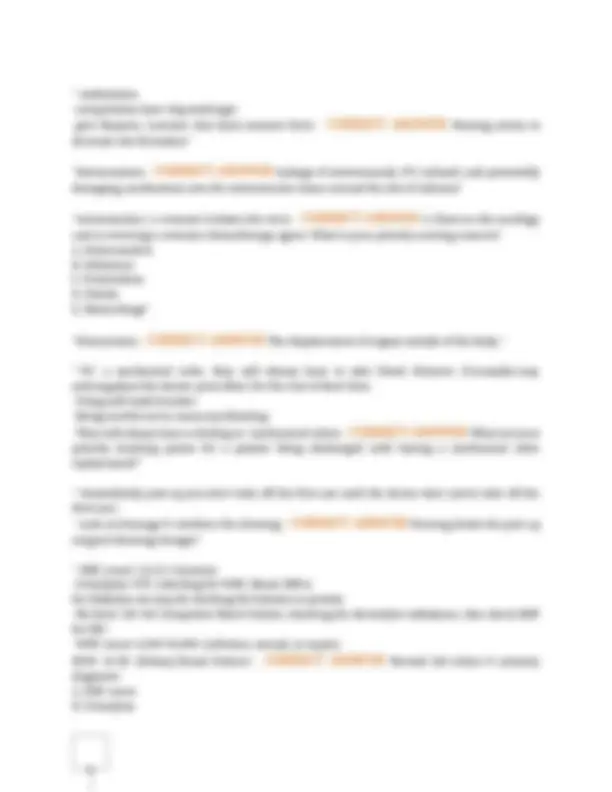
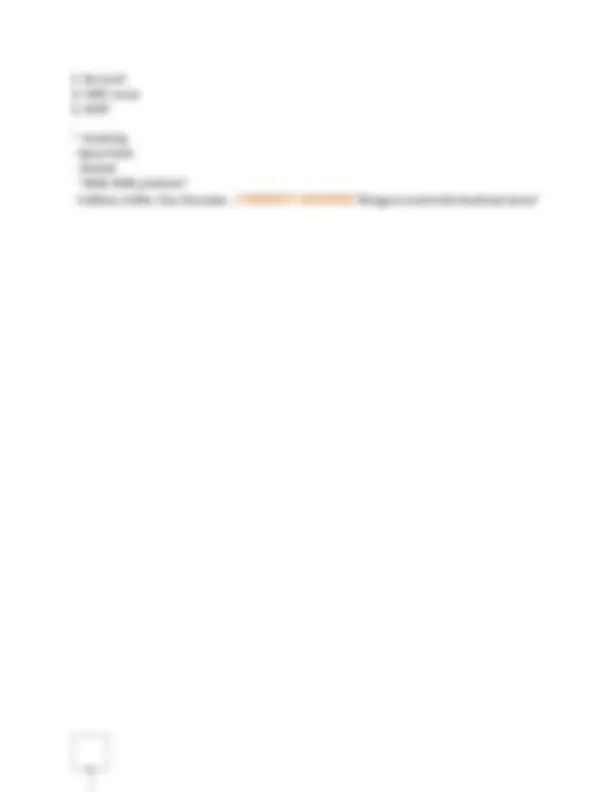


Study with the several resources on Docsity

Earn points by helping other students or get them with a premium plan


Prepare for your exams
Study with the several resources on Docsity

Earn points to download
Earn points by helping other students or get them with a premium plan
Community
Ask the community for help and clear up your study doubts
Discover the best universities in your country according to Docsity users
Free resources
Download our free guides on studying techniques, anxiety management strategies, and thesis advice from Docsity tutors
MED SURG HESI V2 - 2024/2025 EXAM QUESTIONS AND VERIFIED ANSWERS GUARANTEED SUCCESS
Typology: Exams
1 / 27

This page cannot be seen from the preview
Don't miss anything!




















“What information should the nurse include in the teaching plan of a client diagnosed with GERD? A. Sleep without pillows B. Adjust food intake to three full meals per day with no snacks C. Minimize symptoms by wearing loose comfortable clothing
symptoms by wearing loose comfortable clothing" "The nurse is teaching a client with glomerulonephritis about self care. Which dietary recommendations should the nurse encourage the client to follow. A. increase intake of high-fiber foods, such as bran cereal. B. Restrict protein intake by limiting meals and other high-protein foods C. limit oral fluid intake of 500/ml/day
"An overweight young adult male who was recently diagnosed with type 2 DM is admitted for a hernia repair. he tells the nurse that he is feeling very weak and jittery. Which actions should the nurse implement? Select all that apply. A.Check his fingerstick glucose B. Assess his skin temperature and moisture C. Measure his pulse and BP D. Document anxiety on the surgical checklist
glucose, assess his skin temperature and moisture, measure his pulse and BP" "A client with Cushing Syndrome is recovering from an elective laparoscopic procedure. which assessment finding warrants immediate intervention by the nurse? A. Irregular apical pulse B. Purple marks on skin of the abdomen C. Quarter sized blood spot on the dressing
"An adult woman with primary Raynaud phenomenon develops pallor and then cyanosis of her fingers. After warming her hands, the fingers turn red and the client reports a burning sensation. What action should the nurse take?
A. Apply a cool compress to the affected fingers for 20 minutes B. Secure a pulse oximeter to monitor the client's oxygen saturation C. Report the finding to the healthcare provider as soon as possible
Continue to monitor the fingers until color returns to normal" "A male client with muscular dystrophy fell in his home and is admitted with a right hip fracture. His right foot is cool, with palpable pedal pulses. lung are coarse with diminished bibasilar breath sounds. Vital signs are T: 101 degrees, HR: 128, RR: 28, B/P: 122/82. Which interventions is most important for the nurse to implement first? A. Obtain oxygen saturation level. B. Encourage incentivize spirometry C. Assess lower extremity circulation
"A client with cancer is receiving chemotherapy with a known vesicant. the clients IV has been in place for 72hrs. The nurse determines that a new IV site cannot be obtained and leaves present IV in place. What is greatest clinical risk? A. impaired skin integrity B. fluid volume excess C. Acute pain and anxiety
"A postoperative client reports incisional pain. The client has two prescriptions for PRN analgesia that accompanied the client from the post-anesthesia unit. Before selecting which medication to administer, which action should the nurse implement? A. Document client report of pain in EMR B. Determine which prescription will have quickest onset action C. Compare the clients pain scale rating w/prescribed dosing
Compare the clients pain scale rating w/prescribed dosing" "While assisting a female client to the toilet, the client begins to have a seizure and the nurse eases her to the floor. The nurse calls for help and monitors the client until the seizing stops. Which interventions should the nurse implement first? A. Document details of the seizure activity B. Observe for lacerations to the tongue C. Observe for prolonged periods of apnea
seizure activity"
"The nurse is obtaining a clients fingerstick glucose level. After gently milking the clients finger, the nurse observes that the distal tip of the finger appears reddened and engorged. What action should the nurse take? A. Collect the blood sample B. Assess radial pulse volume C. Apply pressure to the site
"A client being admitted to a surgical unit is being evaluated for an intestinal obstruction. The HCP prescribes a NG tube to be inserted and placed to intermittent low wall suction. which intervention should the nurse implement to facilitate proper tube placement. A. Soak NG tube in warm water B. Insert tube with clients head tilted back C. Apply suction while inserting tube
degrees" "A young female client with 7 children is having frequent morning headaches, dizziness, and blurred vision. Her b/p is 168/104. The client reports that her husband recently lost his job and she is not sleeping well. After administering a STAT dose of an antihypertensive IV med, which intervention is important? A. Measure urine output hourly to assess for renal perfusion B. Request a prescription for pain medication C. Use an automated BP machine to monitor for hypotension
hypotension"
to get out what they want to say" "No heavy lifting or bending over at the waste (nothing that will increase IOP ) Wear bandage or shield to protect the eye Eyes will feel like scratchy sand-like feeling in their eyes Need to have someone to drive for them 1st 24 hrs after surgery, they just need to relax (they can watch TV & read; nothing that will cause pressure) Don't want patient rubbing or pressing on their eye
surgery education"
"-Report if they are coughing up blood -Recognize if there is a rupture, there will be bleeding & immediate action needs to be taken -No spicy foods!! -To prevent pressure, you have to control their high blood pressure
Teaching for esophageal varices"
the esophagus"
in __"
expect to see in a patient who had recently been suctioned via endotracheal tube? A. Increased course crackles B. Decreased course crackles C. Decreased fine crackles D. Increased fine crackles" "The patient's sclera is yellow (inflammation b/c of gallstones, the stones can get lodged in the
assessment information will be most important for the nurse to report to the health care provider about a patient with cholelithiasis? A. The patient's urine is bright yellow B. The patient's sclera is yellow C. The patient has increased pain after eating D. The patient complains of chronic heartburn"
"Place the client in high Fowler's position. (They are in respiratory acidosis)
with pneumonia presents with the following arterial blood gases of pH 7.28, PaCO2 of 74, HCO3 of 28 meq/L, and PO2 of 45. Which of the following is the most appropriate nursing intervention? A. Administer a sedative B. Place client in left lateral position C. Place client in high-fowlers position D. Assist the client to breathe into a paper bag What would be your primary assessment for this patient?"
-Will always have to use eyedrops for the rest of their lives -S/S of open angle glaucoma: will have decreased peripheral vision, also it happens very slowly,
disorder. The client reports he thinks he is about to have a seizure. Which of the following actions by the nurse are incorrect? (Select all that apply) A. Monitor for prolonged apnea B. Ease the client to the floor if standing C. Move furniture away from the cient D. Loosen the clients clothing E. Protect the clients head with padding F. Restrain the client G. Turn on side H. Place tongue blade in clients mouth I. Record the time & document details of seizure J. Document details of the seizure" "Looking for a bowel movement (they are going to have massive liquid diarrhea b/c Kayexalate
sodium polystryene sulfonate (kayexalate) orally. What do you want to monitor for immediately after this medication is given?" "D, C, A,B
Sequence the procedure for verifying feeding tube placement: A. Measure the pH of aspirate, compare the color of the strip with the color on the chart provided by the manufactor B. Discard used supplies, remove gloves and discard, and perform hand hygiene C. Draw back on syringe & obtain 5 to 10 mL of gastric aspirate observe appearance of aspirate D. Perform hand hygiene. Apply clean gloves, draw up 30 mL of air into syringe, then attach to end of feeding tube, flush tube with 30 mL of air" "- check for increased HR, respirations, & temp
reaction?"
priority when a transfusion reaction is suspected? A. vital signs B. call the MD C. administer benadryl D. stop the infusion" "Assess immediately and hourly thereafter (something has changed; this is different from their
combative becomes calm & sleeps through the night. What is the nurse's priority intervention? A. Assess immediately and hourly thereafter B. Call the MD C. Document the client is resting D. Allow the patient to rest and document a round every 4 hours" "A. Diet & exercise regimen (least invasive)
is newly diagnosed with type 2 diabetes. Which of the following treatments do you expect the patient to be started on initially? A. Diet and exercise regimen B. Metformin BID by mouth C. Regular insulin subcutaneous D. None, monitoring at this time is sufficient enough" "Review their dietary log (check what they have been eating & keep up with what foods are
fluctuating high and low, what should be the nursing intervention? A. Increase the patients short acting insulin B. Decrease the patients long acting insulin C. Draw a serum glucose D. Review their dietary log"
complication that can occur after abdominal surgery:
experiencing abdominal pain on the med-surg unit. What shoud the RN consider to be the primary assessment? A. Pedal pulses B. Jugular vein distention C. Bowel sounds in all 4 quadrants D. Urinary output of 30 cc per hour" "- Expect to see no BP or sticks in that arm
and tachycardia. What is the RN's first response? A. Complete chest percussions on bilateral lungs B. Push 1 amp o fmetoprolol C. Place the patient in trendelenburg D. Sit the patient in high fowler's What is the priority nursing assessment?" "Assess potassium level (when you're giving insulin & dextrose it pulls K+ out of cells too; it will drop)
administer dextrose + insulin combined as a one time stat dose. What will be most important to include in this patient's plan of care?
A. Assess range of motion B. Assess oxygen level C. Assess potassium level D. Assess glucose readings after each meal" "- Monitor glucose
"RLS (restless leg syndrome) (unable to control the urge to move their legs)
lower legs; irresistible urge to move the legs temporarily relieving the sensation but not disurbing sleep." "Risks: Diabetes, Smoking, Hypertension, Diet (fatty foods/high cholesterol), Family History
Disease: What interventions do you instruct the patient to slow progression of CAD?" "- Stool will be red (bloody diarrhea) (lower)
nurses's primary intervention? A. apply oxygen by non-rebreather mask B. sedate w/ ativan 1mg/kg C. Administer bicarb 1 amp D. Administer a bronchoocnstrictor"
l. Socioeconomic (greater in lower socioeconomic areas)
"a. Pursed lips b. Barrel chest (increase anteroposterior diameter) c. Tripod positioning d. Use of accessory muscles e. ALSO: chronic cough, sputum production, dyspnea, wheezing
"a. Increase fluid intake to 3L/day if tolerated
expectorate thick lung secretions?" "a. Increase water intake to 3L / day b. DECREASE calcium, struvite (uric acid: gout), infections (bacterial: UTIs) c. Strain urine (shows composition of the stone) d. Increase ambulation *Foods to AVOID: calcium (milk, dairy, green leafy vegetables) & caffeine (coffee, tea, soda, chocolate); spinach nuts, wheats, brans, *Take thiazide diuretics to prevent calcium stones; allopurinol or colchicine to prevent uric acid stones; and antibiotics for bacteria (struvite)
Interventions for patient with renal calculi:" "a. Weak cough
(amyotropic lateral sclerosis) intervention? RESPIRATORY (MS lose cognitive function)" "a. Increased protein in the blood; decrease serum albumin b. Edema/swelling/abdominal edema
experiencing expressive aphasia?" "a. No lifting/straining/bending b. No driving for > 2 days c. No contacts d. No alcohol for >24 hours
e. No rubbing or pressing on eyes
"a. Manage airway!!! b. Decrease BP MUST STAY LOW à if ruptures, can bleed easily c. Coughing up blood (red or coffee grounds) d. Avoid acidic/spicy foods & aspirin, alcohol, NSAIDS e. Use beta blockers to keep BP low f. If bleeding occurs: Manage airway (suction) à stabilize the patient à IV therapy (octreotide
LIVER CIRRHOSIS** -> medical emergency" "a. Yellow sclera, jaundice (because backing into the liver) b. Avoid fatty/spicy foods and alcohol c. S/S:
cholelithiasis?" "a. Place patient in high fowlers (allows better oxygen) b. Check RR, respiratory depth, and O2 sat c. Use nonrebreather to keep O2 and release CO d. pH decreased; PaCO2 INCREASED; HCO3- normal or increased (compensation)
acidosis (CO2 excess)" "a. Check cultures (blood, sputum, urine) before starting antibiotics b. Give antibiotics if culture answer is NOT an option
infection)"
ventricular diastolic failure signs and symptoms:" "Safety risk factors:
"Food DECREASES symptoms -> HELPS Mid-epigastric pain beneath xiphoid
"a. Black dome vision "Tunnel vision" ->LOSE PERIPHERAL VISION -> 1ST symptom!!!! b. Pressure eyedrops - lifetime medication
"-Sudden excruciating pain in or around the eye with N/V
angle glaucoma" "-> treatment of High K+ levels a. Watch for DIARRHEA (pulls out potassium and excretes through the bowels) b. If question asks what to look for INITIALLY à Diarrhea
"Hand hygiene/gloves -> Draw 20-30 mL air ->attach tube -> push air -> listen for bubbles ->
"1. Blood should not transfuse more than 4 hours ALWAYS ON A PUMP a. Itching b. Flank/chest pain c. Swelling
"a. Metabolic EMERGENCY b. Rapid release of components due to chemo & radiation into system à renal failure, hyperkalemia, hyperuricemia, hyperphosphatemia, HYPOcalcemia *hypocalcemia means that the body tries to pull calcium out of the bones, which leads to brittle
"1. Do not want patient to sit there and let fluid buildup a. Prevent pneumonia/atelectasis
"a. Check POTASSIUM b. *Rationale: insulin pulls K+ out with glucose
c. *Add D5 or D10 when BS reaches a level of 250 mg/dL DKA: pH decrease, acidosis (fruity breath) TYPE 1
"a. NPO!!!! b. NG suction c. Abdominal ultrasound d. Amylase/lipase levels
"(UC is lower GI) a. Abdominal pain b. Bloody diarrhea / rectal bleeding à main s/s!!!
"After hospitalization for SIADH, a client develops pontine myelinolysis. Which intervention should the nurse implement first? A. Reorient client to room B. Place a patch on one eye C. Evaluate clients ability to swallow
"A male client with heart failure calls the clinic and reports that he cannot put his shoes on because they are too tight. Which additional information should the nurse obtain? A. What time did he take his medication? B. Has his weight changed in the last several days? C. Is he still able to tighten his belt buckle?
the last several days?" "An older adult woman with a long history of COPD is admitted with progressive shortness of breath and a persistent cough, is anxious, and is complaining of dry mouth. which intervention should the nurse implement? A. Administer a prescribed sedative B. Encourage client to drink water C. Apply a high flow Venturi mask
"The nurse is providing preoperative education for a Jewish client scheduled to receive a xenograft to promote burn healing. Which information should the provider this client? A. Grafting increase the risk for bacterial infections B. The xenograft is taken from a non-human source. C. Grafts are later removed by a debriding procedure
from a non-human source" "A male client who had colon surgery 3 days ago is anxious and requesting assistance to reposition. While the nurse is turning him, the wound dehiscences and ulcerates. The nurse moistens an available sterile dressing and places it over the wound. Which intervention should the nurse implement next. A. Bring additional sterile dressing supplies to the room. B. Prepare the client to return to the OR C. Obtain a sample of the drainage to send to the lab
dressing supplies to the room" "A client with carcinoma of the lung is complaining of weakness and has a serum sodium level of 117/meq. Which nursing problem should the nurse include in the clients plan of care. A. Altered urinary elimination B. Impaired gas exchange C. Fluid volume excess
"A female client enters the clinic and insists on being seen. She is weak, nervous and reports a racing heart beat and recent weight loss of 15 pounds. After ruling out substance withdrawal, the MD suspects hyperthyroidisms and admits her for testing. which action should the nurse do? A. Begin preparing the client for thyroidectomy procedure B. Space the clients care to provide periods of rest C. Assess the client for hyperactive bowel sounds
hyperactive bowel sounds" "The nurse is completing the preoperative assessment of a client who is scheduled for a laparoscopic cholecystectomy under general anesthesia. which finding warrants notification of the HCP prior to proceeding with the scheduled procedure? A. light yellow coloring of the clients skin and eyes. B. The clients blood pressure reading 184/88mm C. The client vomits 20 mL of clear yellowish fluid
blood pressure reading 184/88"
"A client who has a history of hyperthyroidism was initially admitted with lethargy and confusion. Which additional finding warrants the most immediate action by the nurse? A. Facial puffiness and periorbital edema B. Hematocrit of 30% C. cold and dry skin
"Following surgical repair of the bladder, a female client is being discharged from the hospital to home with an indwelling urinary catheter. Which instruction is most important for the nurse to provide to this client? A. Avoid coiling the tubing and keep if free of kinks B. Cleanse the perineal area with soap and water twice daily C. Keep the drainage bag lower than the level of the bladder
back lower than the level of the bladder" "Which client has the highest risk for developing skin cancer? A. A 16 year old dark skinned female who tans in tanning bed once a week. B. A 65 year old fair skinned male who is a construction worker C. A 25 year old dark skinned male who mother had skin cancer.
old fair skinned male who is a construction worker" "When caring for a client with nephrotic syndrome, which assessment is most important for the nurse to obtain? A. Daily weight B. Vital signs C. Level of consciousness
"A female client client who was involved in a motor vehicle collision is admitted with a fractured left femur which is immobilized using a fracture traction splint in prep for an open reduction internal fixation (ORIF) the nurse determines that her distal pulse are diminished in the left foot. Which interventions should the nurse implement? (SATA) B. Verify pedal pulses using a Doppler C. Monitor left leg for pain, pallor, paresthesia, paralysis, pressure
monitor left leg for pain, pallor, paresthesia, paralysis, pressure, evaluate the splint to the left leg" "A male client with heroes zoster (shingles) on his thorax tells the nurse that he is having difficulty sleeping. what is the etiology of this problem?